Lodhi Art District: taking art to Delhi’s streets
A complex of former military homes in the Indian capital is the setting for an international street art project
For many, the term ‘Indian art’ will bring to mind the colourful, detailed works of the Mughal Empire or the intricate carvings adorning Khajuraho’s ancient temples. These days, however, there’s a much more contemporary feel to Indian art, thanks to a flourishing street art scene in several locations across the country.
Chief of these is Lodhi Art District in Delhi, India’s pulsating capital. At the start of the century there were just a handful of contemporary galleries in the city (such as Art Alive Gallery and Nature Morte) which competed for attention with Delhi’s more traditional historical and archaeological galleries. That was until 2014, when St+art India Foundation – a non-profit using art to help boost urban regeneration in public spaces – began making plans for a project based around mass-creation of art on public walls and buildings in South Delhi.
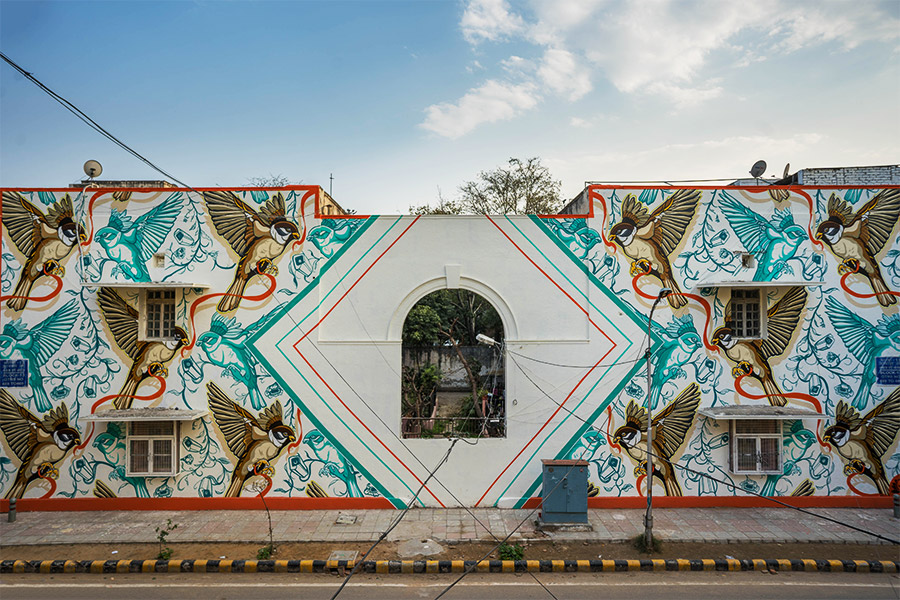
Cause and Effect by Sam Lo at Lodhi Art Festival 2019 / Image: Pranav Gohil - St+art India Foundation

“The aim was to make art accessible for all, to get it out of the private spaces like museums and galleries, and put it on the streets,” says St+art India co-founder and festival director Arjun Bahl. Located near the hip Hauz Khas neighbourhood, Lodhi Art District explores “how we can make the Indian streets more active and playful and fun, and also engage with the communities as well as people from outside the city,” Arjun adds. The district stretches across two square kilometres and contains 65 pieces of street art (and counting), created by artists representing over 25 different nationalities. The murals range from colourful scenes portraying Indian culture to thought-provoking artworks commenting on equality, the environment and other social issues.
Based in one of the last complexes built under British rule, Lodhi Colony is a grid of former military homes, originally built largely as residential properties for government workers and still now used for that purpose. All around Lodhi, murals are sprawled across building exteriors, bringing life to properties that are slowly deteriorating.
The location was chosen due to the simple architecture of the buildings and the large, open walls that act as canvases for artists, plus there’s ample space to make it easier for visitors to move around. “We needed a space which is more pedestrian friendly, more centrally located and which has these kinds of homogenous facades,” says St+art India Foundation co-founder and artistic director Hanif Kureshi. “All these answers were found in Lodhi Colony.”
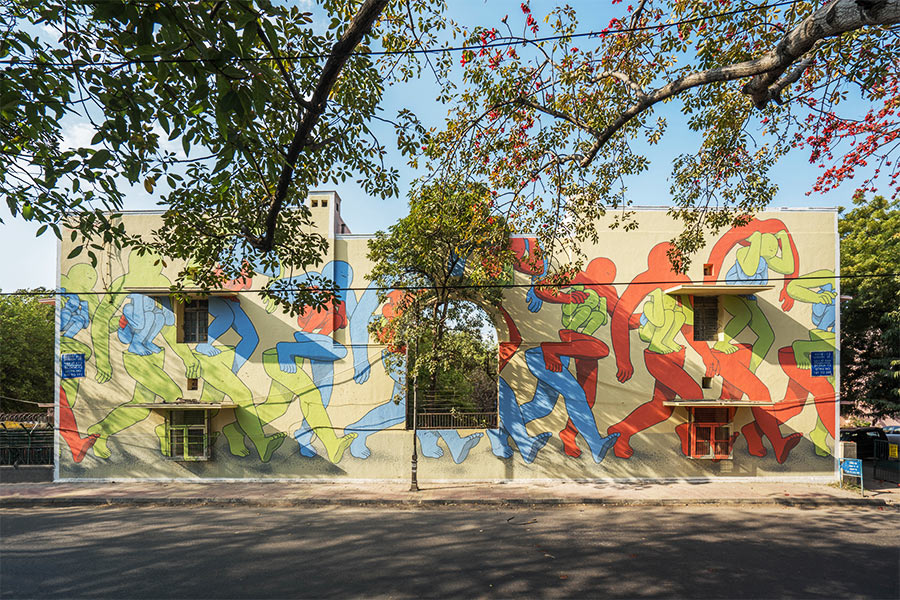
Belly Dance by Dutch artist Daan Botlek / Image: Pranav Gohil - St+art India Foundation

The experience of wandering Lodhi’s streets differs from that of exploring other art districts. Typically, art districts are created in abandoned neighbourhoods and around disused buildings, as a means of regenerating an area or bringing to life to somewhere forgotten. What makes Lodhi unique is that many of its buildings are still residential properties, and a vibrant community already existed in the area when the murals began to appear. This community is just as central to the project as the art.
Arjun explains: “Communities are involved as much as possible in the whole process of making art.” St+art India co-founder and project director Thanish Thomas adds that most residents of Lodhi Colony “are very happy to have something like this, and they have a sense of pride that something like this is there … They want to get involved, they want their family members to get involved.” This community collectivism was demonstrated when Lodhi’s residents came together to deal with vandalism in the area by purchasing their own paint and fixing it themselves, retaining the pride they have in their neighbourhood.
“The aim was to make art accessible for all, to get it out of the private spaces and put it on the streets”
Tourists, bloggers and creatives now flock to the area to see the murals, and this interaction itself has even been captured by a couple of the artists, Avinash and Kamesh, in their piece The Tourist. Thanish explains that this mural of a young visitor eagerly snapping away on his camera is a commentary on how the selfie generation tend to interact with the street art – from behind a lens.
Other important elements of Indian life, culture and history are also represented on Lodhi’s walls, including mythology. Spanning an entire exterior wall and archway, Hanif highlights Vishvaroopa by Indian artist Inkbrushnme as a charming piece that depicts the supreme form of Vishnu as Krishna (both are key Hindu deities), with the universe in his mouth.
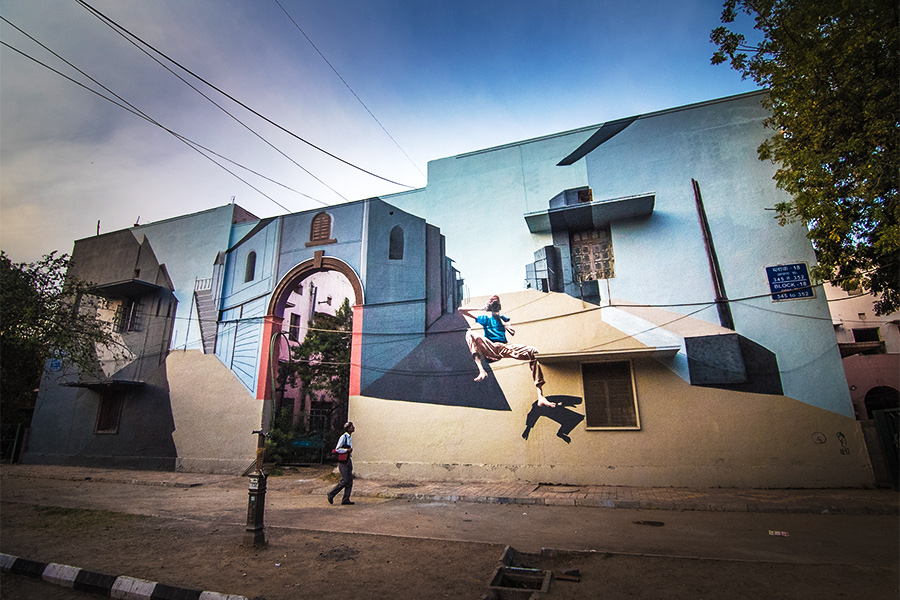
Art reflecting life... The Tourist by Avinash and Kamesh at Lodhi Art Festival 2019 / Image: St+art India Foundation

Lodhi’s residents have also set up a community wall where people from around the area can create murals of their own, as a way of empowering individuals who might not otherwise get a chance to express their creativity. As with so much of the artwork in Lodhi, it’s about creating a dialogue and engaging with the community, most of whom have reacted extremely positively.
Some do have concerns, as shown by a story that Hanif shares about one of Lodhi’s wall murals depicting several crows. “There are two different types of people: ones who really like it and the others who really hate it, who say that since the crows appeared on the wall, their business has gone down.”
Sadly, many of the buildings in Lodhi are facing natural decay, and crumbling facades are becoming an increasingly common challenge to battle against. Coupled with redevelopment happening in many local neighbourhoods, it’s important to consider what the future might hold for Lodhi Art District. The St+art team recognise that the murals might not last forever. “We’ll try to find [another] space in Lodhi, but we can’t force it. It needs to speak to the work we do and be careful about gentrification – that’s a huge issue with art. There has to be a mindful process, being sensitive to the communities around it and the need for buy-in and blessings from the governments.”
With such change potentially on the horizon, now is clearly the time to explore Lodhi Art District and consider the messages housed across its many walls. It’s unarguably one of Delhi’s most captivating areas.
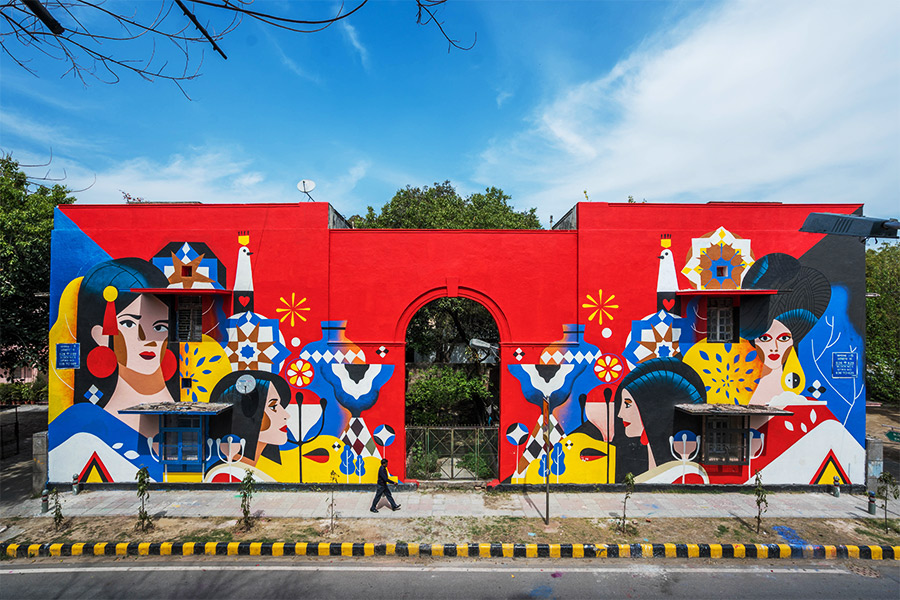
Sajid Wajid's mural, Shakti / Image: Pranav Gohil - St+art India Foundation

The piece is inspired by the location of the wall. It stands right in front of a boys’ school, and when we went to interact with the staff, I noticed that almost 95% of the school staff were women. Then when school ended, I saw a crowd of mothers waiting for the kids. It was a sight that made me think of women as unsung heroes.
It took me and my team of two assistants a week to paint the mural, as we were working with unforeseen rain and a harsh Delhi winter.
The use of bright pop colours in the mural makes for a great photo opportunity and a distinct landmark. The murals in Lodhi Art District are not just art for arts sake, they serve many purposes. Apart from creating an open-air art gallery and inspiring people from all walks of life, they also serve as landmarks.
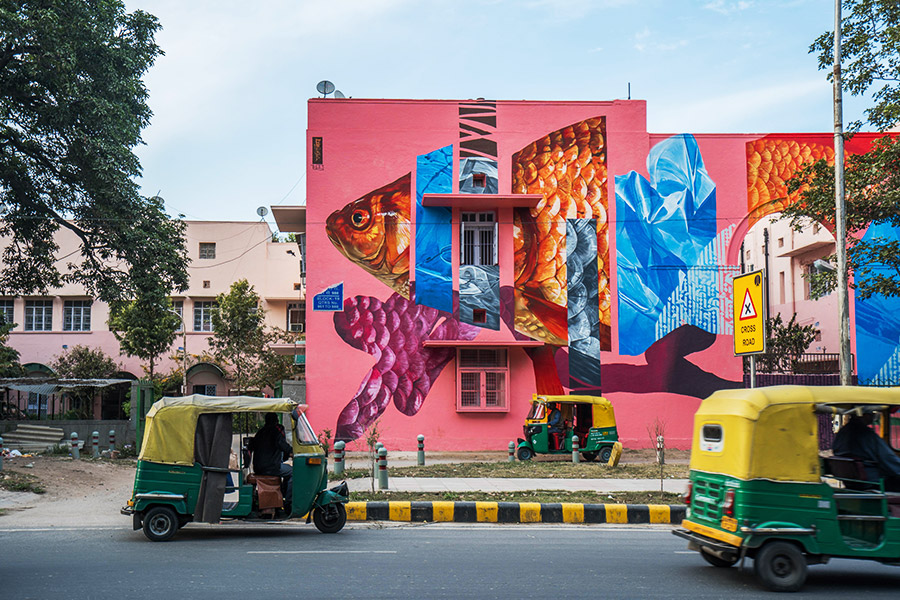
H11235's mural, I am Here / Image: Pranav Gohil - St+art India Foundation

The theme I was given was the city and the water, and that was an interesting basis for me. I had always been listening to hear about the rise of various forms of pollution in the city of Delhi, time and again, so I knew I wanted to talk about that. But I wanted to bring an interesting new angle other than what we always hear. I wanted to talk about Delhi’s Yamuna river, but I just didn’t want it to be another generic mural about river pollution.
I am a strong supporter of conducting research first, so I started researching and came across an interesting article, which talked about how the local fish population was being decimated by an invasion of ‘alien fish’, which were pet goldfish being intentionally dumped by locals. The thought of something considered so beautiful and harmless wrecking havoc in the environment was fascinating to me, because I consciously-unconsciously try to bring the narrative of contradiction to my works. Thus, the mural (Ma Yaha Chu / ‘I am here’) was born.
It was painted in 11 days and the colours were intentionally chosen. The pastel, non-threatening hue in the background represents the non-harmful essence of a goldfish on first look, but the subtle use of reds and deep purples foreshadows the idea behind it. As with all my other works, this mural is an exploration of the contradicting world we live in.
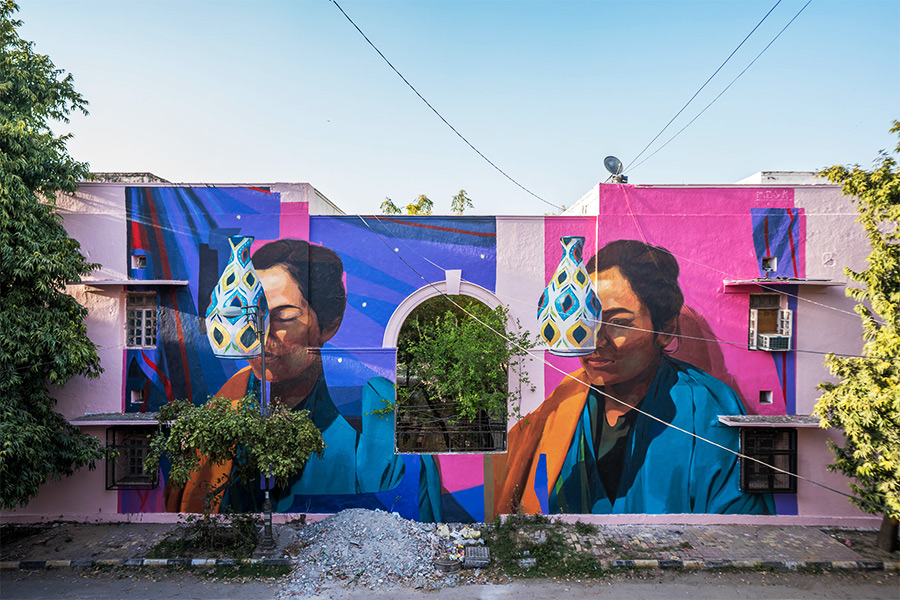
Manolo's mural, About Dreams and Reality / Image: Pranav Gohil - St+art India Foundation

When I arrived in Lodhi Art District and began to live with its inhabitants, I discovered that all its ethnic groups, cultures and religions coexisted with a common link: their spirituality. I came from a very different place, much more atheist, more mechanical, less spiritual. In my work, I try to build on a concept of ‘resistance’ as a way of finding other meanings within things or people.
In this mural, resistance hides within us like meditation. I wanted to paint a dream sequence where life is full of magic. I always try to make my painting subjective, to question the viewer and make them try to understand their artifice.
Whenever I get to the wall where I am going to paint, I try to be influenced by everything surrounding me. In this case, I was very impressed by the culture of colour in India. Then I analysed the environment and looked at the colour of the buildings around me, at all the green trees, the grey asphalt of the street. I like to use colours that contrast with everything around the piece I’m painting and its meaning.
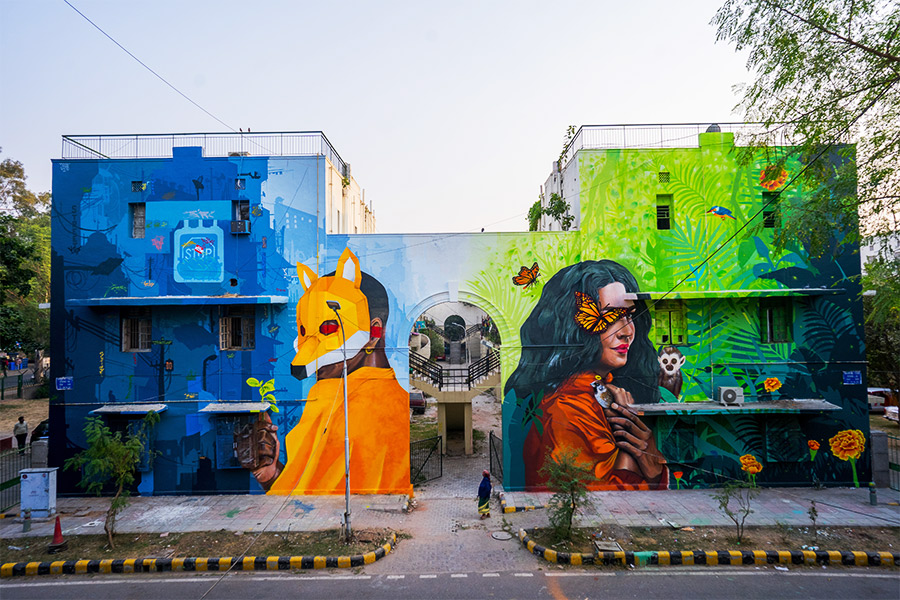
Zero's mural, Jungle Lockdown / Image: Pranav Gohil - St+art India Foundation

The Covid lockdown inspired this work. The mural portrays the possibilities of the Garden of Eden, as nature reclaims its lost space and teaches us a lesson in healing. It is a reminder that we have to lose something in order to rebuild better. Perhaps the man in the mural – caught in the city – hopes for the same kind of future, too, portrayed by the tulsi plant that he holds on to.
It took a lot of time to sketch out the concept clearly, and then it took 15 days to complete, with the help of two assistants.
I have been in awe of nature and its beauty for the longest time, so the colour palette came through nature itself. The greens and blues were specifically thought of, because of the jungle theme. Fun fact: a hummingbird visited us on the site, while I was completing the mural, and it gave me a first-hand idea of the vivid colours of the bird in the painting.